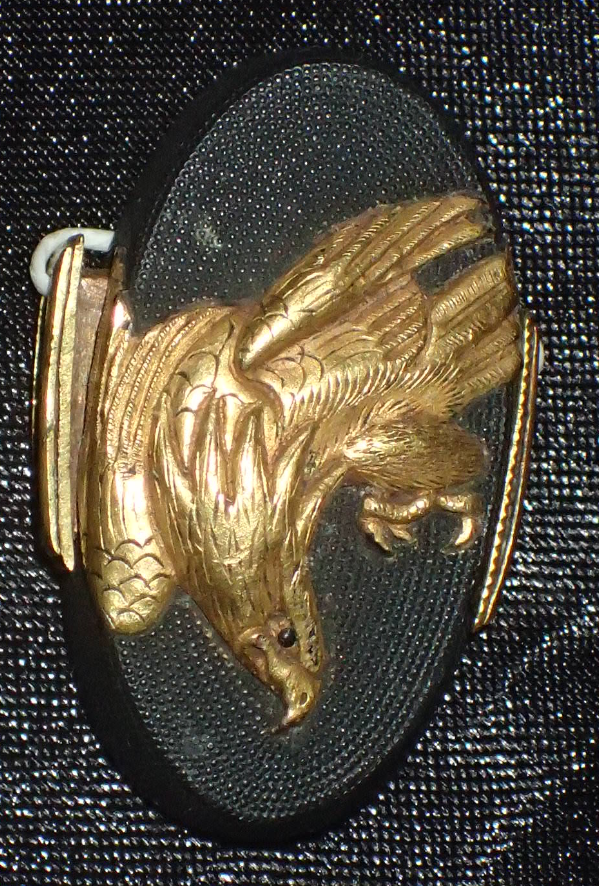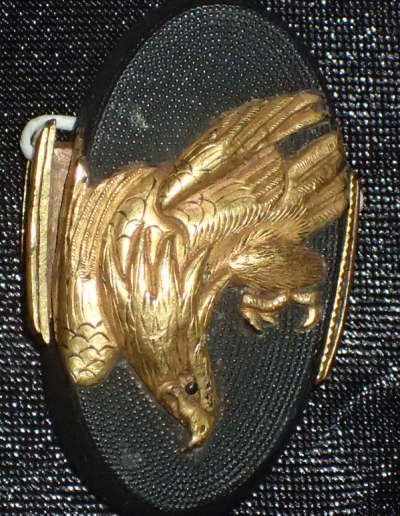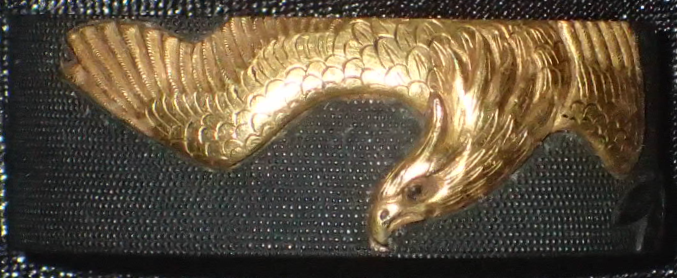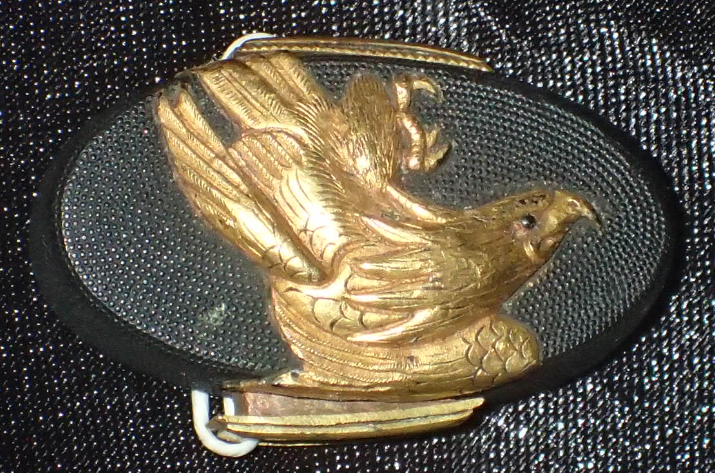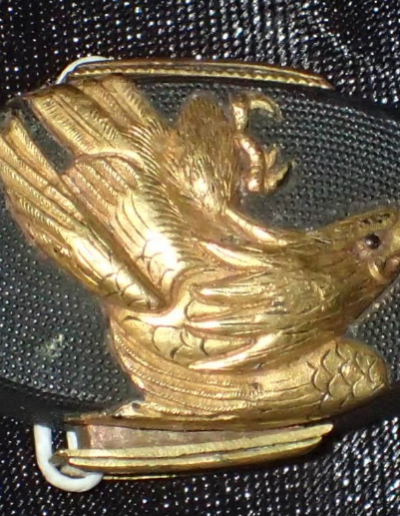Display Only
Extremely Rare set of Fuchi Kashira by Soju
Mōkin no zu fuchigashira (猛禽図縁頭) ‒ Fuchi Kashira depicting birds of prey
Signed: Sōju + kaō (宗寿「花押」)
Shakudō with Nanako ground, Takabori relief, gold iroe
The Yokoya school (横谷)
Yokoya Sōmin (横谷宗珉), 2nd gen. Yokoya, 1st gen. Sōmin
Yokoya Sōmin was born in Edo as the son of the 1st gen. Sōyo in the
tenth year of Kanbun (1670). His first name was „Chōjirō“ (長二郎)
but he later adopted his fathers first name „Jibei“ (治兵衛). His civilian
name was „Tomotsune“ (友常) and at the beginning of his career he
signed with the name „Sōchi“ (宗知). He was also employed by the
bakufu and contemporary records say that he worked first as a
preparatory craftsman for his father and other, unspecified, Gotō
masters. At the age of 21, after the death of Sōyo in Genroku three
(1690), he started his own business. It is unknown when he started
using the name „Sōmin“ but on the basis of extant signed works we can
say that this was the case at the latest in the ninth year of Genroku
(1696) when he was 27. Later he voluntarily renounced his post at the
bakufu. There are several theories about the reasons for this but the
most accepted one is that his urge to work artistically independent was
so strong that he saw himself forced to take this step. He feared that if
he continued to work for the bakufu he would be doomed to make
pieces in Gotō style for the rest of his life.
Yokoya Sōmin ́s creative period was at the time of the boom of the
Edo culture, i.e. the Genroku and Kyōhō eras, when in the east an
antipole to the old-established culture of Kyōto started to emerge. As
mentioned in chapter 6.1, the machibori trend breathed new life into the
world of sword fittings, not only in terms of motifs but also in terms of
interpretation, combination of colours, and raw materials. Sōmin is
considered today as the pioneer of the machibori movement. He was the
first who worked in pure katakiribori without additional hira-zōgan
applications and who used a vertical-format composition on kozuka.
The otherwise undecorated katakiribori looks simple at a glance but
was strongly influenced by contemporary painters who in turn tried to
get rid of the classical subjects of, for example, the Kanō school.
Sōmin ́s personal influence goes to a large extent back to the Edo
painter Hanabusa Itchō (英一蝶, 1652-1724). Their friendship began
when Sōmin was about 40. The relationship was quite close, Sōmin
used sketches by Itchō for his kinkō works and even accommodated
Itchō ́s mother for eleven years when the latter was banished to the
island of Miyakejima (三宅島) for eleven years due to his „eccentric“
lifestyle. By the way, the banishment lasted from the eleventh year of
Genroku (1698) until the fifth year of Hōei (1709), when Itchō was
pardoned.
In his later years Sōmin entered priesthood under the name „Ton ́an“
(遯庵). He had no children and so he adopted first a son from the Ueda
family (植田) but the adoption – which lasted from the second year of
Hōei (1705) to the fifth year of Shōtoku (1715) – was later dissolved.
Upon this he adopted Tomosada (友貞), the second son of his student
Yokoya Sōju (宗寿),*43 who succeeded as the 3rd gen. Yokoya and as the 2
nd gen. Sōyo. Sōmin died on the sixth day of the eighth month of
Kyōhō 18 (1733) at the age of 64. Like Sōyo, he is buried in Asakusa ́s
Tōkōji.
*43 According to a theory, Sōju was the brother or brother-in-law of Sōmin and was also trained by
the 1st gen. Sōyo. The sources on Sōju ́s death date also differ greatly. One says he died in Kyōhō
19 (1734) at the age of 64 and others in Kei ́an three (1650) at the age of 84.
Yokoya Sōyo (横谷宗與), 3rd gen. Yokoya, 2nd gen. Sōyo
The 3rd gen. Yokoya or the 2nd gen. Sōyo respectively was the
second son of Sōju. His civilian name was Yokoya Densaburō
Tomosada“ (横谷伝三郎友貞) and he was born in Edo in the 13th year
of Genroku (1700). Adopted by Sōmin he succeeded as head of the
Yokoya family at the age of 34. His oldest son followed him as the 4
th gen. Yokoya and 2nd gen. Sōmin when he retired in the third year of
Meiwa (1766). This Yokoya Sōyo used the gō „Shōkei“ (照渓).
His second son was Densaburō Tomotake (伝三郎友武) whose
kinkō artist name is unknown or rather of whom we only know
signatures like „Tomotake + kaō“ or „Yokoya Tomotake + kaō“. One
such piece is dated the second year of Tenmei (1782) and is therefore an
important reference for the chronological attribution of this artist about
which several theories exist. Some say Tomotake was the 2nd gen. Sōyo,
but the latter died on the 28th day of the sixth month An ́ei eight (1779)
at the age of 80, and this does not match with the aforementioned piece
with the date of Tenmei two. However, Sōyo ́s third son was the poet
Yokoya Genpu (横谷玄甫).
2nd gen. Yokoya Sōyo.
11.4 Yokoya Sōmin (横谷宗珉), 4th gen. Yokoya, 2nd gen. Sōmin
The civilian name of the 2nd gen. Sōmin was „Yokoya Chōjirō
Tomotsugu“ (横谷長二郎友次). He was the oldest son of the 2nd gen.
Sōyo and used the gō „Ichian“ (一庵) and „Shōan“ (晴庵). He
succeeded as head of the Yokoya family when his father retired in
Meiwa three (1766) but died before the latter, namely on the 25th day of
the fifth month of Meiwa eight (1771). He was succeeded by Kiryūsai
Sōmin (起竜斎宗珉) – with the first name „Gonnosuke“ (権之助) –
who originally came from the Uchida family (内田) and who worked
first as a Gotō sub-contractor. When the 10th Gotō-gen. Renjō (廉乗,
1627-1708) went to Edo he was accompanied by his workers Aoki
Jō ́un (青木常雲), Nakamura Jōki (中村常喜) and Jōsei (常清), and
Uchida Jōyū (内田常有, his craftsman name can also be read
„Tsuneari“). Jōyū and his son Uchida Jōsei (内田常生) in turn did
foundation work for the kozuka and kōgai of the 13th and 14th Gotō-
gen., i.e. Enjō (延乗, 1721-1784) and Keijō (桂乗, 1751-1804).
Kiryūsai Sōmin was the oldest son of Jōsei and worked, as mentioned,
as a preparatory craftsman for Gotō Keijō until the age of 29. Some say
that he bought the family name „Yokoya“ from a Yokoya family
member *44 and that he installed himself as the 5th gen. Yokoya because
there was no successor after the early death of the 2nd gen. Sōmin.
*44 It is said that he arranged a wedding with the much older daughter of the 2nd gen. Sōyo.
Kiryūsai Sōmin’s date of birth and death can not be ascertained but
some records mention Kansei seven (1795) as his year of birth. If this is
correct then the Yokoya family was without an official head for more
then 40 years, which seems to be unlikely. Incidentally, there was
another kinkō artist of the Oda family (小田), active around the
bakumatsu era, who called himself „7th gen. Sōmin“ and used the gō
„Kiryūsai“. So it is likely that Oda Sōmin was a successor, maybe the
grandson of Uchida Sōmin.
_ The Japanese Tōsō-Kinkō Schools
Markus Sesko

